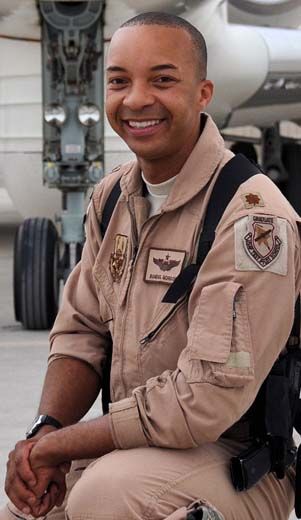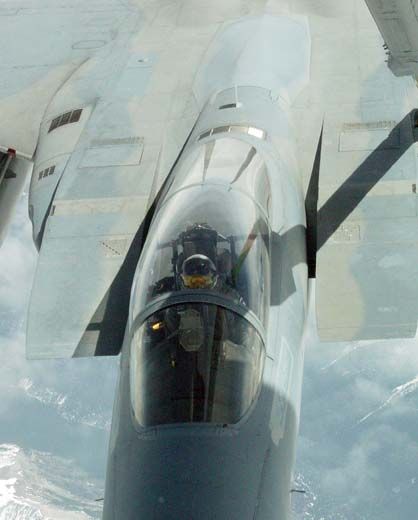Over the No-Fly Zone
Patrolling over northern Iraq in 2001 felt like driving through a small town with Hell’s Angels.
/https://tf-cmsv2-smithsonianmag-media.s3.amazonaws.com/filer/Northern_Watch-flash.jpg)
Inside the shelter, my F-15C was loaded for action with eight air-to-air missiles bristling under the wings and fuselage, hundreds of armor-piercing 20mm bullets in the Gatling gun, three bulbous external fuel tanks, and a full load of chaff and flare countermeasures—a fearsome load that would be the nightmare of any MiG pilot. The marriage of air-to-air weapons, twin afterburning engines, and powerful air intercept radar made the F-15C THE top air superiority fighter, with an impressive 104:0 air-to-air kill ratio. Performing the preflight walkaround in the early morning, checking the jet like a jockey inspecting his horse before the big race, the emotional reality of the moment finally caught up with me: Today I would fly into combat for the first time.
In 2001 I was a young U.S. Air Force 1st Lieutenant a year out of the F-15C training unit at Tyndall Air Force Base in Florida, assigned to the 19th Fighter Squadron “Gamecocks” at Alaska’s Elmendorf Air Force Base. I knew just enough about the F-15C and air-to-air tactics to get myself in real trouble—a polite way to say that I felt bulletproof and unafraid. We were assigned to take part in Operation Northern Watch, a coalition effort to enforce protective no-fly zones over the Kurds in northern Iraq. But as far as I was concerned, it was my chance to bag an enemy MiG. I knew the chances were very slim, and that the last MiG shootdown in the area had taken place nearly a decade earlier. But there were no other wars for the F-15C on the horizon and the last wars involving the F-15C occurred while I was in school or in training. I figured that Northern Watch was IT for pilots in my generation.
Northern Watch was purely a defensive scenario in which all combat assets existed to support us Eagle drivers. Normally, the F-15C plays a supporting role, acting as the air-to-air blockers so the strike package can get through and wreak havoc on the enemy. But here, the F-15C was the quarterback, with all the bomb droppers, electronic surveillance, and jamming aircraft clearing the way for us to sweep the skies for any sign of Iraqi aircraft threatening the Kurds. It wasn’t MiG Alley over the Yalu in North Korea, Vietnam, Kosovo, or Desert Storm, but it certainly was bad-guy land where people would take potshots at me with large caliber surface-to-air weapons, and where the political value of a captured American fighter pilot was huge.
All the small nit-noy minutia about some obscure cockpit switch, aircraft system mode, or weapons function that everyone glossed over in training as unimportant suddenly took on the seriousness of a heart attack. And there was so much more to know then our own aircraft’s capabilities. We had to be smart on Iraqi culture and geography, enemy weapons systems, airspace procedures, secure communications protocols, search-and-rescue plans, and a seemingly endless list of rules of engagement that determined when and how we could employ lethal force.
Since we were in a combat zone, we could never be certain whether or not there was an enemy operative waiting off the departure end of the runway with a shoulder-fired missile. It was the first time I took off with the express intention of being erratic and unpredictable. I lined up on the runway next to my flight lead, checked my engines and flight instrument, and waited until he turned his head to look at me. I signaled that my pre-takeoff checks were complete. He saluted back smartly and began his takeoff run. I watched in awe as his F-15, barely 30 feet to my right, lurched forward as the twin afterburners thundered. The jet was so heavy with fuel and weapons that it seemed as though the takeoff was unfolding in slow motion. The deafening roar of almost 50,000 pounds of thrust shook my jet. He blasted down the runway and lifted off into the distance. I followed moments later.
As I eased the jet airborne and retracted the landing gear, I scanned the ground for any pigtail-shaped smoke trails, the tell-tale sign of a shoulder-fired missile. I checked left and right, clearing my flight path as I steadily pulled the nose steeper and steeper with the engines at maximum power, all the while keeping my fingers close to the chaff and flare countermeasures switch. I kept thinking, “Get speed and altitude…speed and altitude.” Once safely up and away, my only thought was “All departures should be this much fun!”
Soon we were crossing the border between good-guy land and Iraq. It was as benign as driving across a state border except there was no sign reading “President Saddam Hussein welcomes you to the wonderful country of Iraq.” There was, however, a shift in my thinking: For the first time, I was over hostile territory.
Looking down over northern Iraq, my first impression was that it was…beautiful. In the far northern regions was a crown of massive snow-capped mountains with glacial valleys and streams that fed the farmland fanning out below. Well south of this Alpine-like mountain range, rolling hills and lakes gave way to expansive plains that housed large ancient cities connected by a relatively modern highway network. In front and below was the historic city of Irbil. Historians believe that it is one of the oldest inhabited cities in the world. It featured an intricate network of inner roads emanating from a 100-foot-tall mound at the city center that marked the city’s ancient beginnings. Almost directly west of Irbil was Mosul, the largest city of Northern Iraq. The Tigris River meandered from the northwest to southeast, neatly bisecting the city. The south end of Mosul featured a large air base that garnered much attention from us because of the enemy aircraft that may have used it. There was an entire population of Iraqis living out their lives seemingly oblivious to the huge coalition air force circling overhead.
Patrolling around the airspace of northern Iraq was akin to being a roving Hell’s Angels biker gang driving through a small town. By design, intimidation of the enemy through our very presence was a large part of our tactics to force the enemy into compliance. Around me was a fleet of attack, surveillance, and jamming aircraft. As the air-to-air fighters in this fleet, our role was to busily sweep the airspace with our radars looking for violations of the No-Fly zone. We had more firepower at our disposal then most small countries. This was the “new normal” of global diplomacy through military peacekeeping. We were not there to save the world, but to simply function like police preserving the status quo via the threat of force rather than the actual use of force. After more than a decade of no-fly zone enforcement, both sides had become accustomed to the other side’s presence and tactics. Patrol was many hours of boredom punctuated by moments of excitement.
Cruising along at altitude, I noticed a curious formation of popcorn like small grayish clouds that had suddenly formed about 100 yards off my jet. Suddenly, the first string of popcorn was joined by another series just ahead and to my left, except this time I noticed the small explosions that preceded it. It was then that I realized that the Iraqi gunners far below had correctly calculated our formation’s altitude and speed. Now they were just honing their firing solution. My flight lead also saw that we were right in the middle of an Iraqi fireworks display and immediately called for evasive maneuvers. I slid the throttles to maximum power and began to aggressively maneuver. Steep dives and climbs, unpredictable sweeping turns to left and right, large changes in aircraft G force—anything I could do to spoil the Iraqi gunner’s solution.
The anti-aircraft explosions were still going off all around us but over time I could tell that they were gradually fading aft. Soon we were clear of the danger without so much as a scratch. I am now a firm believer in the statement, “Nothing is more thrilling than to be shot at and missed.” In the solitude of my single-seat jet, I laughed uncontrollably for a few moments. It is an awesome release of adrenalin when you’ve faced something you were anxious about and lived to tell the tale.
For the remainder of my NORTHERN WATCH missions, I learned that these sorties were a great test of endurance. Spending several grueling hours in the cramped confines of a fighter cockpit, flying formation, running the aircraft’s sensors, dodging the occasional anti-aircraft fire, and sucking almost 50 tons of fuel from an airborne tanker over several hookups strained the concentration of the best of us. Of course at the end of all this, you still had to land safely back at base. I never had any problems going to sleep after flying these missions.
I never did get my MiG. Then again, neither did anyone else during or even after my deployment to Iraq. Unlike our air-to-ground brethren who have an almost unlimited amount of things to attack on the ground, an air-to-air fight requires enemy participation. There simply wasn’t anything to shoot at. They knew better than to try their luck against heavily armed F-15Cs. I did, however, have the honor of getting shot at by Iraqi gunners on all but one of my missions. I also had the opportunity to fly top cover for a strike against an Iraqi surface-to-air site that had attacked one of our coalition aircraft. The site was obliterated in a massive fireball. Never again would it threaten coalition pilots.
On the last mission, after leaving Iraqi airspace, I raised my fist in defiance at the Iraqi surface-to-air gunners. I fully expected to one day return to Northern Watch. But a few months later, the terror attacks of September 11th would occur, forever altering the landscape of warfare. To date, NORTHERN WATCH was the last sustained combat presence of the U.S. Air Force F-15C.
Major Randy J. Gordon is an experimental test pilot for the “Red Devils” of the 40th Flight Test Squadron at Eglin Air Force Base in Florida. He has flown combat missions over Iraq during Operation NORTHERN WATCH and over Afghanistan in support of Operation ENDURING FREEDOM.

